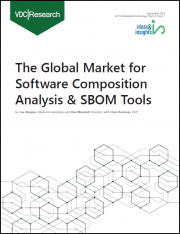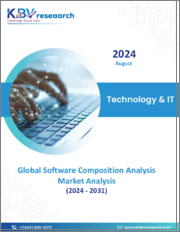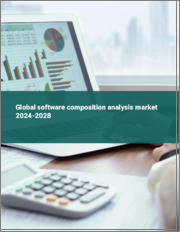
|
시장보고서
상품코드
1588491
소프트웨어 구성 분석 시장 규모, 점유율, 성장 분석, 컴포넌트별, 도입 유형별, 조직 규모별, 업계별, 지역별 - 산업 예측(2024-2031년)Software Composition Analysis Market Size, Share, Growth Analysis, By Component, By Deployment Type, By Organization Size, By Vertical, By Region - Industry Forecast 2024-2031 |
||||||
세계의 소프트웨어 구성 분석 시장 규모는 2022년에 3억 9,870만 달러에 달하며, 2023년 4억 8,322만 달러에서 2031년까지는 22억 4,993만 달러로 성장하며, 예측 기간 중(2024-2031년) CAGR은 21.20%로 성장할 전망입니다.
소프트웨어 구성 분석(SCA)은 오픈소스 위협과 취약점 증가에 직면한 중요한 솔루션으로 등장했으며, 오픈소스 코드의 채택이 증가하고 있는 추세와 완벽하게 일치한다, 소프트웨어 개발 수명주기의 모든 단계에 걸쳐 소프트웨어 코드를 철저하게 평가합니다. 소프트웨어의 결함을 사전에 식별하고 해결함으로써 조직은 악의적인 악용에 의한 잠재적 침해를 방지할 수 있습니다. 오픈소스 소프트웨어(OSS)에 대한 수요가 증가하는 이유는 원활한 통합, 다양한 컴포넌트의 가용성, 비용 효율성 등 다양한 이점이 있기 때문입니다. 그러나 이러한 장점은 라이선스 컴플라이언스 문제, 보안 취약점, 품질 보증 위험 등의 문제와 밀접한 관련이 있으며, SCA는 라이선스 컴플라이언스 자동 점검, 합리적인 취약점 식별 및 해결, 특정 비즈니스 요구에 맞는 정책 구현의 유연성 강화 등 큰 이점을 제공합니다. 강화 등 큰 이점을 제공합니다. 또한 SCA 툴은 지속적인 개발 프로세스를 지원하는 원활한 제품 통합을 촉진하여 조직이 소프트웨어 위험을 효과적으로 관리할 수 있도록 돕습니다. 오픈소스 환경이 계속 진화함에 따라 소프트웨어 구성 분석의 수용은 점점 더 중요해지고 있으며, 안전하고 효율적인 개발 환경을 가능하게 하는 동시에 사용자에게 수명주기 전반에 걸쳐 소프트웨어에 대한 필요한 제어를 제공합니다. 오픈소스와의 통합이 증가하고 있음을 보여주는 데이터와 인사이트을 통해 SCA는 급증하는 사이버 위협으로부터 용도를 보호하려는 기업에게 중요한 전략적 투자로 부각되고 있습니다.
목차
서론
- 조사의 목적
- 정의
- 시장 범위
조사 방법
- 정보 조달
- 2차·1차 정보원
- 시장 규모 예측
- 시장의 전제조건과 제한
개요
- 시장 개요 전망
- 공급 수요 동향 분석
- 부문별 기회 분석
시장 역학과 전망
- 시장 역학
- 촉진요인
- 기회
- 억제요인
- 과제
- Porter의 산업 분석
주요 시장 인사이트
- 주요 성공 요인
- 경쟁의 정도
- 주요 투자 기회
- 시장의 에코시스템
- 사례 연구 분석
- 기술 분석
- 공급망 분석
- PESTEL 분석
- 밸류체인 분석
소프트웨어 구성 분석 시장 : 컴포넌트별
- 시장 개요
- 솔루션
- 기능
- 취약성 탐지
- 리스크 관리, 경고, 리포트
- 라이선스 관리
- 폴리시 관리
- 수복
- 서비스
- 전문 서비스
- 기획·컨설팅
- 트레이닝·교육
- 지원·정비
- 매니지드 서비스
소프트웨어 구성 분석 시장 : 도입 유형별
- 시장 개요
- 온프레미스
- 클라우드
소프트웨어 구성 분석 시장 : 조직 규모별
- 시장 개요
- 대기업
- 중소기업
소프트웨어 구성 분석 시장 : 업계별
- 시장 개요
- BFSI
- 정부·방위
- 통신·IT
- 소매업·E-Commerce
- 헬스케어
- 제조업
- 자동차
- 기타
소프트웨어 구성 분석 시장 : 지역별
- 시장 개요
- 북미
- 미국
- 캐나다
- 유럽
- 독일
- 스페인
- 프랑스
- 영국
- 이탈리아
- 기타 유럽 지역
- 아시아태평양
- 중국
- 인도
- 일본
- 한국
- 기타 아시아태평양
- 라틴아메리카
- 브라질
- 기타 라틴아메리카 지역
- 중동 및 아프리카(MEA)
- GCC 국가
- 남아프리카공화국
- 기타 중동 및 아프리카 지역
경쟁 구도
- 상위 5사의 비교
- 주요 기업의 시장 포지셔닝(2023년)
- 주요 시장 기업이 채택한 전략
- 시장에서의 최근 활동
- 주요 기업의 시장 점유율(2023년)
주요 기업 개요
- Synopsys(US)
- Sonatype(US)
- Contrast Security(US)
- nexB(US)
- Snyk Ltd.(UK)
- Checkmarx(Israel)
- GitLab Inc.(US)
- JFrog Ltd.(US)
- FOSSA, Inc.(US)
- Revenera(US)
- SonarSource SA(Switzerland)
- Mend(formerly WhiteSource)(US)
- Aqua Security(Israel)
- ShiftLeft, Inc.(US)
- ArmorCode Inc.(US)
- Phylum(US)
- Anchore Inc.(US)
- OpenScan Technologies, Inc.(US)
- CycloneDX(US)
- Codenotary(US)
- Dependency-Track(OWASP)(US)
Global Software Composition Analysis Market size was valued at USD 398.7 million in 2022 and is poised to grow from USD 483.22 million in 2023 to USD 2249.93 million by 2031, growing at a CAGR of 21.20% during the forecast period (2024-2031).
Software composition analysis (SCA) has emerged as a crucial solution in the face of growing open-source threats and vulnerabilities, aligning perfectly with the increasing adoption of open-source code. SCA tools conduct thorough evaluations of software code throughout all stages of the software development life cycle, focusing on the security of open-source components. By identifying and addressing software flaws proactively, organizations can prevent potential breaches due to malicious exploitation. The escalating demand for open-source software (OSS) can be attributed to its numerous advantages, including seamless integration, diverse component availability, and cost-effectiveness. However, these benefits come hand-in-hand with challenges, such as license compliance issues, security vulnerabilities, and quality assurance risks. SCA offers significant advantages, including automated checks for license compliance, streamlined identification and resolution of vulnerabilities, and enhanced flexibility in policy implementation to meet specific business needs. Additionally, SCA tools facilitate seamless product integration to support continuous development processes, empowering organizations to manage software risks effectively. As the landscape of open-source continues to evolve, the acceptance of software composition analysis is becoming increasingly vital, providing users with the necessary control over their software throughout its lifecycle while enabling a secure and efficient development environment. With data and insights pointing to a rise in open-source integration, SCA stands out as a key strategic investment for companies looking to safeguard their applications against burgeoning cyberthreats.
Top-down and bottom-up approaches were used to estimate and validate the size of the Global Software Composition Analysis market and to estimate the size of various other dependent submarkets. The research methodology used to estimate the market size includes the following details: The key players in the market were identified through secondary research, and their market shares in the respective regions were determined through primary and secondary research. This entire procedure includes the study of the annual and financial reports of the top market players and extensive interviews for key insights from industry leaders such as CEOs, VPs, directors, and marketing executives. All percentage shares split, and breakdowns were determined using secondary sources and verified through Primary sources. All possible parameters that affect the markets covered in this research study have been accounted for, viewed in extensive detail, verified through primary research, and analyzed to get the final quantitative and qualitative data.
Global Software Composition Analysis Market Segmental Analysis
Global Software Composition Analysis Market is segmented by Component, Deployment Type, Organization Size, Vertical, and region. Based on Component, the market is segmented into Solution, and Services. Based on Deployment Type, the market is segmented into On-Premises, and Cloud. Based on Organization Size, the market is segmented into Large Enterprises, and Small and Medium-Sized Enterprises. Based on Vertical, the market is segmented into Banking, Financial Services, and Insurance, Government and Defense, Telecom and IT, Retail and Ecommerce, Healthcare, Manufacturing, Automotive, and Others. Based on region, the market is segmented into North America, Europe, Asia Pacific, Latin America and Middle East & and Africa.
Driver of the Global Software Composition Analysis Market
The Global Software Composition Analysis (SCA) market is significantly driven by the increasing internet browsing habits and the widespread adoption of mobile devices, particularly following the closure of schools and universities. This surge in digital engagement has heightened the demand for secure and efficient software solutions. Additionally, the rapid growth of e-commerce, coupled with the escalating use of real-time gross settlement systems (RTGS) and mobile transactions, underscores the necessity for robust software composition analysis tools. These tools are essential for identifying vulnerabilities within software components, thereby ensuring compliance and security in an increasingly complex digital ecosystem.
Restraints in the Global Software Composition Analysis Market
One of the significant market restraints for the Global Software Composition Analysis (SCA) market stems from the challenges posed by a high rate of false positives during scans. These erroneous alerts can lead to substantial wasted resources, as developers often invest considerable time and finances investigating and rectifying issues that ultimately do not pose genuine threats. Additionally, the complexity and advanced nature of SCA tools can overwhelm users who lack extensive cybersecurity expertise, potentially deterring their adoption and effective utilization. This perception of SCA technologies as cumbersome not only hampers developer productivity but also impacts overall market growth.
Market Trends of the Global Software Composition Analysis Market
The global software composition analysis (SCA) market is witnessing a significant trend towards the integration of SCA tools with DevOps methodologies. As organizations prioritize rapid product delivery to stay competitive, incorporating security into the DevOps pipeline has become crucial. This integration allows for real-time vulnerability detection and remediation seamlessly within continuous integration and continuous deployment (CI/CD) workflows. SCA solutions are evolving to support these fast-paced development cycles, ensuring that security measures do not hinder deployment efficiency. Consequently, the demand for agile, automated SCA tools is rising, positioning them as essential components for modern software development practices.
Table of Contents
Introduction
- Objectives of the Study
- Definitions
- Market Scope
Research Methodology
- Information Procurement
- Secondary & Primary Data Sources
- Market Size Estimation
- Market Assumptions & Limitations
Executive Summary
- Market Overview Outlook
- Supply Demand Trend Analysis
- Segmental Opportunity Analysis
Market Dynamics & Outlook
- Market Dynamics
- Drivers
- Opportunities
- Restraints
- Challenges
- Porters Analysis
- Competitive rivalry
- Threat of Substitute Products
- Bargaining Power of Buyers
- Threat of New Entrants
- Bargaining Power of Suppliers
Key Market Insights
- Key Success Factor
- Degree of Competition
- Top Investment Pockets
- Ecosystem of the Market
- Case Study Analysis
- Technology Analysis
- Supply Chain Analysis
- PESTEL Analysis
- Value Chain Analysis
Software Composition Analysis Market by Component
- Market Overview
- Solution
- Capabilities
- Vulnerability Detection
- Risk Management, Alerting, And Reporting
- License Management
- Policy Management
- Remediation
- Services
- Professional Services
- Planning And Consulting
- Training And Education
- Support And Maintenance
- Managed Services
Software Composition Analysis Market by Deployment Type
- Market Overview
- On-Premises
- Cloud
Software Composition Analysis Market by Organization Size
- Market Overview
- Large Enterprises
- Small And Medium-Sized Enterprises
Software Composition Analysis Market by Vertical
- Market Overview
- BFSI
- Government and Defense
- Telecom and IT
- Retail and Ecommerce
- Healthcare
- Manufacturing
- Automotive
- Others
Software Composition Analysis Market Size by Region
- Market Overview
- North America
- USA
- Canada
- Europe
- Germany
- Spain
- France
- UK
- Italy
- Rest of Europe
- Asia Pacific
- China
- India
- Japan
- South Korea
- Rest of Asia-Pacific
- Latin America
- Brazil
- Rest of Latin America
- Middle East & Africa (MEA)
- GCC Countries
- South Africa
- Rest of MEA
Competitive Landscape
- Top 5 Player Comparison
- Market Positioning of Key Players, 2023
- Strategies Adopted by Key Market Players
- Recent Activities in the Market
- Key Companies Market Share (%), 2023
Key Company Profiles
- Synopsys (US)
- Company Overview
- Business Segment Overview
- Financial Updates
- Key Developments
- Sonatype (US)
- Company Overview
- Business Segment Overview
- Financial Updates
- Key Developments
- Contrast Security (US)
- Company Overview
- Business Segment Overview
- Financial Updates
- Key Developments
- nexB (US)
- Company Overview
- Business Segment Overview
- Financial Updates
- Key Developments
- Snyk Ltd. (UK)
- Company Overview
- Business Segment Overview
- Financial Updates
- Key Developments
- Checkmarx (Israel)
- Company Overview
- Business Segment Overview
- Financial Updates
- Key Developments
- GitLab Inc. (US)
- Company Overview
- Business Segment Overview
- Financial Updates
- Key Developments
- JFrog Ltd. (US)
- Company Overview
- Business Segment Overview
- Financial Updates
- Key Developments
- FOSSA, Inc. (US)
- Company Overview
- Business Segment Overview
- Financial Updates
- Key Developments
- Revenera (US)
- Company Overview
- Business Segment Overview
- Financial Updates
- Key Developments
- SonarSource SA (Switzerland)
- Company Overview
- Business Segment Overview
- Financial Updates
- Key Developments
- Mend (formerly WhiteSource) (US)
- Company Overview
- Business Segment Overview
- Financial Updates
- Key Developments
- Aqua Security (Israel)
- Company Overview
- Business Segment Overview
- Financial Updates
- Key Developments
- ShiftLeft, Inc. (US)
- Company Overview
- Business Segment Overview
- Financial Updates
- Key Developments
- ArmorCode Inc. (US)
- Company Overview
- Business Segment Overview
- Financial Updates
- Key Developments
- Phylum (US)
- Company Overview
- Business Segment Overview
- Financial Updates
- Key Developments
- Anchore Inc. (US)
- Company Overview
- Business Segment Overview
- Financial Updates
- Key Developments
- OpenScan Technologies, Inc. (US)
- Company Overview
- Business Segment Overview
- Financial Updates
- Key Developments
- CycloneDX (US)
- Company Overview
- Business Segment Overview
- Financial Updates
- Key Developments
- Codenotary (US)
- Company Overview
- Business Segment Overview
- Financial Updates
- Key Developments
- Dependency-Track (OWASP) (US)
- Company Overview
- Business Segment Overview
- Financial Updates
- Key Developments















